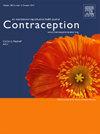在全州范围内开展的 "避孕药具普及行动:Path4you "中,多布斯之后避孕方法选择的变化情况
IF 2.8
2区 医学
Q1 OBSTETRICS & GYNECOLOGY
引用次数: 0
摘要
目标多布斯诉杰克逊妇女健康组织案的判决极大地影响了堕胎机会,印第安纳州于 2022 年 8 月成为第一个立法禁止堕胎的州。本研究的目的是评估使用全州避孕药具获取计划 PATH4YOU 的参与者在避孕方法选择上的变化。我们的假设是,由于担心意外怀孕时无法获得堕胎服务,更多的人会选择有效性更高的避孕方法。方法我们分析了 2021 年 9 月至 2023 年 9 月期间通过 PATH4YOU 接受护理的 1,224 名育龄人群的项目数据,其中包括多布斯法案前的 178 人和多布斯法案后的 1,034 人。所有参与者都接受了怀孕意愿筛查、综合避孕咨询/决策支持以及当天免费可逆避孕方法的使用。我们通过年龄和邮政编码对研究人群进行了分析,包括社会贫困指数(SDI)以及多布斯决定前后的避孕方法组合。根据邮政编码,88%的参与者为城市居民,在 SDI 四分位数中平均分布(22% 在最贫困的四分位数中,26% 在最不贫困的四分位数中)。总体而言,35% 的参与者选择了 LARC,31% 选择了避孕药/避孕贴/避孕环,12% 选择了注射,3% 选择了屏障/EC,11% 选择了其他/无。在多布斯决定之后,明显有更多的参与者选择了更有效的方法,包括 LARC(37% vs 24%,p<0.001)和注射剂(13% vs 5%,p=0.003),而选择药/贴/环的人数则较少(29% vs 41%,p=0.03)。本文章由计算机程序翻译,如有差异,请以英文原文为准。
CHANGES IN CONTRACEPTIVE METHOD CHOICES FOLLOWING DOBBS IN A STATEWIDE CONTRACEPTIVE ACCESS INITIATIVE: PATH4YOU
Objectives
The Dobbs v Jackson Women’s Health Organization decision significantly impacted abortion access, and Indiana was the first state to legislate an abortion ban in August 2022. The objective of this study was to evaluate changes in contraceptive method choice among participants using our statewide contraceptive access initiative, PATH4YOU. Our hypothesis was that more people would choose contraceptive methods with higher effectiveness due to concern for lack of abortion access in case of unintended pregnancy.
Methods
We analyzed programmatic data of 1,224 reproductive-aged people receiving care through PATH4YOU from September 2021 to September 2023, including 178 pre-Dobbs and 1,034 post-Dobbs. All participants received pregnancy intention screening, comprehensive contraceptive counseling/decision support, and same-day, free reversible method access. We analyzed the study population via age and zip code, including the social deprivation index (SDI), and the method mix before and after the Dobbs decision.
Results
The average age of participants was 28 years; 77% received care in-person, 23% via telehealth. Based on zip code, 88% were urban and were evenly split among the SDI quartiles (22% in the most vs 26% in the least deprived quartiles). Overall, participants chose 35% LARC, 31% pill/patch/ring, 12% injectable, 3% barrier/EC, and 11% other/none. After the Dobbs decision, significantly more participants chose more effective methods, including LARC (37% vs 24%, p<0.001) and injectables (13% vs 5%, p=0.003), while fewer chose pill/patch/ring (29% vs 41%, p=0.03).
Conclusions
The Dobbs decision and concerns about abortion access appear to have influenced contraceptive method choice for participants in PATH4YOU.
求助全文
通过发布文献求助,成功后即可免费获取论文全文。
去求助
来源期刊

Contraception
医学-妇产科学
CiteScore
4.70
自引率
17.20%
发文量
211
审稿时长
69 days
期刊介绍:
Contraception has an open access mirror journal Contraception: X, sharing the same aims and scope, editorial team, submission system and rigorous peer review.
The journal Contraception wishes to advance reproductive health through the rapid publication of the best and most interesting new scholarship regarding contraception and related fields such as abortion. The journal welcomes manuscripts from investigators working in the laboratory, clinical and social sciences, as well as public health and health professions education.
 求助内容:
求助内容: 应助结果提醒方式:
应助结果提醒方式:


